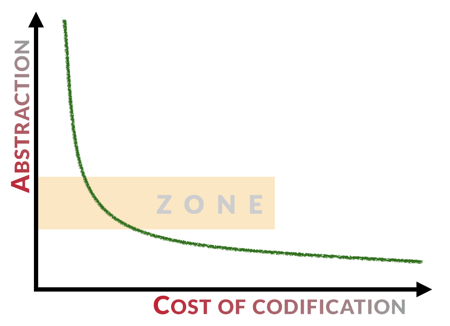Menu

 Over the last year or so I’ve been reviewing some of the original knowledge management (KM) work from twenty-plus years ago and the illustration to the left is from the introduction to the CBI Handbook on KM which I edited in IBM days after my first meeting with Max Boisot at Warwick University. Students of Max’s work (and everyone should be) will recognise two dimensions of the I-Space.
Over the last year or so I’ve been reviewing some of the original knowledge management (KM) work from twenty-plus years ago and the illustration to the left is from the introduction to the CBI Handbook on KM which I edited in IBM days after my first meeting with Max Boisot at Warwick University. Students of Max’s work (and everyone should be) will recognise two dimensions of the I-Space.
I was reminded of it when Niels Pflaeging attacked a post by Henry Mintzberg on silos and slabs. Our friendly neighbourhood management exorcist (yes that really is how Neils self-identifies) took issue with Henry’s statement that “We need silos for the sake of specialization in our organizations, just not ones with impenetrable walls. To use another metaphor, it’s not seamlessness we need in our organizations but good”. To quote the exorcist “Sorry, but no, we do not need silos for specialisation! #Specialization happens when people achieve #mastery through disciplined practice. People are “specialised” (“multi-specialised”, ideally), not groups. Grouping “same-specialisation masters” in silos achieves nothing”. This is pretty typical bluster from Neils. He rarely thinks too hard before sounding off and rarely researches material before making claims. He likes to make sensational statements to get attention and while there is nothing wrong with that per se, there is some obligation to think a little first. But I am grateful to him for drawing my attention to the post from Henry, one of the greats in Management Science by the way.
Complaints about silos go way back. It is one of the common excuses for failure in KM and other fields of work. The reality is that people have been complaining about silos for centuries; I found stuff in Ancient Greek history when I looked a couple of decades ago and it has continued ever since so maybe it’s time to question the excuse and think differently. Henry helps us with that and reminded me of that KM diagram which opens this post. You have to remember that the big thing in knowledge management, then as now (regrettably) was codification. The principle was that knowledge wasn’t a company asset until it was written down so that it was possessed independently of the employee and there was a concern (attributed to a Hewlett-Packard CEO but I haven’t been able to verify it) that the companies knowledge walked out of the door every night. Some of us argued that they might be better off spending the money on making sure that it walked back in the next day but that was thinking against the stream. There was also a dominant idea around setting up communities of practice (CoP) by subject area to further this goal. The whole CoP movement originated from research by Étienne Wenger who studied the way in which people sharing a common concern or passion created virtual spaces to share what they knew. I taught with Étienne a few times and we both agreed and disagreed on aspects of the field. My concern was, and is, that in codifying the end point of an emergent process he had created a recipe that people would copy rather than replicate the social process which had formed it. From that and other factors came the second major Cynefin paper Complex Acts of Knowing which remains one of the most cited papers in the field. It introduced the idea of informal and emergent networks as the primary generators of knowledge and the source from which more formal communities could be created.
The diagram which opens this post is fundamental to that. It basically argues that there is an optimal level of codification which is linked to the shared abstractions of the knowledge holders. The green line shows this. The highest level of abstraction is where I have a conversation with myself, I share all the same training, experiences and the like so nothing is left to chance and the cost of any codification is low – a few scribbles on a notepad is sufficient. At the other extreme if I have to share my knowledge with everyone the cost of codification approaches the infinite, as I can make few and fewer assumptions about what other people already know. A conversation between a small group of people with deep knowledge of a field includes language and references which have to be explained outside of that context. I, therefore, argued that there was a zone of acceptable abstraction in which any knowledge could be sensibly codified. For that reason silos are key, otherwise, too much time and energy are lost. So within a silo knowledge of that field can advance without that inhibition.
The downside is that the silos need to connect and that is best done by generating informal networks between the silos – our Entangled Trios method for example, or in formal processes such as the Triopticon. As Henry says you find ways to connect people within the silos not abandon the silos. Managing the informal channels for contextual knowledge to flow is as important as the formal management of knowledge as information.
Join the first-ever Virtual Cynefin Knowledge Management Basecamp in 2024! Learn more about these principles and how we build and refresh resilient knowledge ecosystems and sense-making capabilities for better decision-making, innovation and learning.
The banner picture is cropped from an original by Waldemar Brandt on Unsplash
Cognitive Edge Ltd. & Cognitive Edge Pte. trading as The Cynefin Company and The Cynefin Centre.
© COPYRIGHT 2024

This is a follow-up to my earlier post which used the metaphor of navigation to ...
I promised to complete the decision series before the Twelvetide blog sequence starts up tomorrow ...